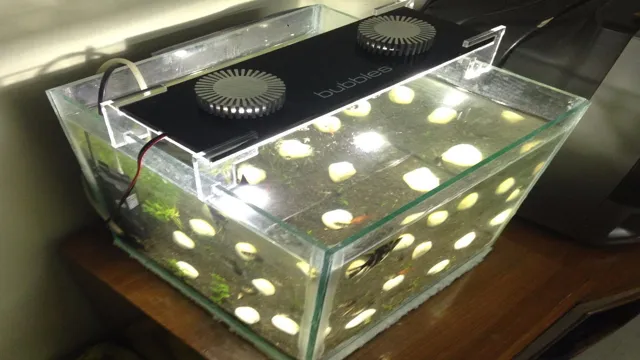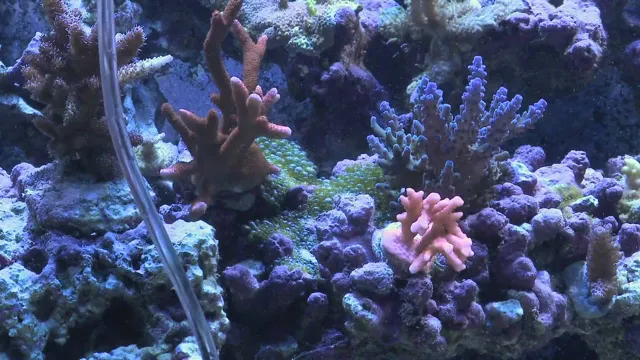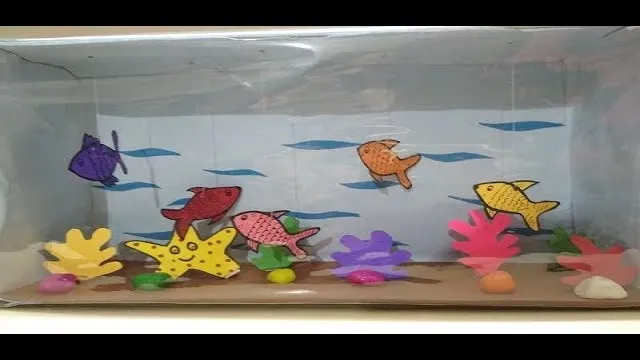Hello fellow aquarium enthusiasts! Are you looking for a way to add some natural greenery to your aquarium? Look no further than creating your very own moss mesh! Not only does it add a beautiful touch to your aquascape, but it also provides great hiding places for your fish and shrimp. Plus, it’s easier to make than you may think! In just 5 easy steps, you can have a gorgeous addition to your tank that your aquatic pets will adore. So grab some moss and let’s get started!
Step 1: Gather Materials
If you’re looking to create a natural and inviting environment in your aquarium, mesh moss is a great addition. To start, gather the necessary materials. You’ll need mesh fabric, scissors, moss, fishing line or thread, and optionally, suction cups or magnets to attach the mesh to the aquarium walls.
The mesh fabric should have a small enough weave to keep the moss in place but allow water flow. You can find such fabric at your local craft store or online. The moss can be gathered from your backyard or purchased from a nursery or pet store.
Ensure it is a type that’s suitable for aquarium use. Once you have your materials, it’s time to start creating your mesh moss.
Moss
To begin cultivating moss, you’ll need to gather some basic materials. The first thing you’ll need is moss itself. While it’s possible to take moss from the wild, it’s generally better to purchase it from a supplier.
This way, you’ll be certain that you have the correct type of moss for your climate and growing conditions. Additionally, purchasing moss is often more sustainable, as wild moss populations can be easily overharvested. You’ll also need a growing medium for your moss.
This can be made of a variety of materials, such as soil, vermiculite, or coconut coir. Finally, you’ll need a container to grow your moss in. This can be anything from a simple flowerpot to a more elaborate terrarium.
Whatever container you choose, make sure it has good drainage to prevent water from collecting and drowning your moss. By gathering these basic materials, you’ll be well on your way to successfully growing lush and vibrant moss.

Mesh
When it comes to creating a mesh, the first step is to gather all the necessary materials. The most important element is, of course, the mesh itself. The type of mesh you choose will depend on the intended use of your project.
If you’re creating a mesh for a window screen, for example, you’ll want to choose a small enough mesh size to prevent insects from getting through. On the other hand, if you’re creating a mesh for a garden fence, you’ll want a larger mesh size to allow plants or vines to grow through. Other materials you’ll need include scissors or a box cutter for cutting the mesh to size, and fasteners such as wire, clamps, or clips to attach the mesh to a frame or support structure.
It’s important to choose fasteners that will hold the mesh securely without causing damage or tearing. By carefully selecting your materials, you can ensure a successful mesh project that meets your specific needs.
Scissors
Scissors When it comes to using scissors, it’s important to have the right materials at hand. First and foremost, you’ll need a pair of scissors. Depending on what you’re cutting, you might need a specific type of scissor—fabric scissors for sewing, for example, or kitchen shears for food prep.
It’s also crucial to have a sturdy surface to cut on, like a cutting board or desk. You’ll want to protect the surface you’re cutting on and prevent any damage to your scissors. Finally, it’s a good idea to keep a towel or rag nearby to clean your scissors as needed, especially if you’re working with sticky or messy materials.
By gathering these basic materials, you’ll be well-prepared to start using your scissors for a variety of tasks.
Fishing Line
When it comes to fishing, one of the most important tools you’ll need is fishing line – without it, you won’t be able to catch anything! But what kind of line should you use? There are several factors to consider, including the type of fish you’re trying to catch, the method you’ll be using (such as casting or trolling), and the water conditions. Some popular options include monofilament, braided, and fluorocarbon line. You’ll also need a fishing rod and reel, as well as some basic tackle like hooks and weights. (See Also: How to Clear Yellow Tint Aquarium Water in 5 Simple Steps)
Make sure to do your research and choose quality equipment – it can make a big difference in your fishing success!
Step 2: Cut the Mesh to Size
After gathering the appropriate materials for creating mesh moss for your aquarium, the next step is to cut the mesh to size. Take the mesh and measure it against the surface where you plan to place it in your aquarium. Use a pair of scissors or a razor blade to trim the mesh to the desired shape and size.
Ensure that it fits nicely and covers the intended surface. This step is crucial as it determines how much moss you can cover and how secure the mesh is while in your aquarium. Leaving excess mesh can be prone to tangling, which could cause debris or accidentally come in contact with your aquatic animals.
Therefore, it is best to keep your mesh precisely cut to size, ensuring that your moss will grow tightly on it and create a natural-looking habitat for your aquatic plants and animals. Remember to dispose of any trimmed mesh responsibly to avoid polluting your environment. With this step completed, you are now ready for the next step, which involves selecting the right type of moss to grow on your mesh.
Measure the size of your aquarium
Now that you have measured the size of your aquarium, it’s time to move on to step two of creating the perfect mesh cover – cutting the mesh to size. As you may know, mesh covers are essential for keeping your aquarium safe from curious pets or even the occasional toddler who might want to put their hands in the water. The best type of mesh to use for this project is fiberglass or aluminum, which won’t rust or react with the water in your aquarium.
Once you have chosen the right mesh, use a measuring tape to measure the length and width of your aquarium, taking into account the height of the tank as well. Then, use a pair of scissors or a blade to cut the mesh to the right size, being careful not to leave any jagged edges as these can harm your aquatic pets. Remember to leave a bit of extra mesh around the edges so that it can be secured to the tank using suction cups or other fasteners.
By following these simple steps, you can create a custom mesh cover that will keep your aquarium safe and secure.
Cut the mesh to fit the size of your aquarium
When it comes to creating a mesh cover for your aquarium, you’ll need to make sure you have the right size for your tank. The second step in this process is to cut the mesh to fit the size of your aquarium. Start by measuring the length and width of your tank to ensure you get an accurate measurement.
Once you have your measurements, use a pair of sharp scissors or a utility knife to carefully cut the mesh to the appropriate size. Remember to leave a little extra on all sides to account for any overlap or to allow for adjustments. Once you’ve cut the mesh to the correct size, it’s time to move on to the next step in creating your aquarium cover.
Don’t worry if you make a mistake – you can always trim the mesh down further if needed. With a little patience and attention to detail, you’ll have a perfectly fitting mesh cover in no time at all.
Step 3: Attach the Moss
Now comes the fun part – attaching the moss! This step is crucial to creating a healthy ecosystem for your aquarium. First, rinse your moss to remove any debris and excess dirt. Then, gently separate the mesh squares and evenly distribute the moss onto each one.
Use fishing line or cotton thread to secure the moss onto the mesh by tying it tightly in a crisscross pattern. Keep in mind that not all mosses are created equal – some require different amounts of light and nutrients. Make sure to research the specific type of moss you have and place it in the appropriate location in your aquarium.
With a bit of patience and care, your mesh moss ball will thrive and contribute to a beautiful underwater world.
Attach the moss to the mesh using fishing line
Now it’s time to tackle the tricky part: attaching the moss to the mesh. But don’t worry, with a bit of patience and some fishing line, you’ll be able to get the job done. Start by carefully placing the moss onto the mesh, making sure to cover as much of the surface area as possible. (See Also: How to Clean Aquarium with Brown Algae: Best Tips and Tricks)
Once you’re happy with the placement, take a piece of fishing line and tie a knot around the moss and mesh. Be sure to make it tight enough to keep the moss in place but not so tight that it damages the delicate plant. Continue tying knots around the moss at regular intervals until you’ve covered the entire mesh.
Don’t be afraid to use multiple pieces of fishing line to secure the moss even further. With a bit of practice, attaching the moss to the mesh will become second nature. Keep in mind that the more securely the moss is attached, the better it will grow.
So take your time and make sure it’s done right.
Attach the moss in a pattern or randomly
When attaching moss to a surface, you have the option of creating a pattern or placing it randomly. It all comes down to personal preference and the overall look you wish to achieve. If you want something more symmetrical, a patterned placement may be more suitable, such as arranging the moss in a geometric shape or even creating a design.
However, if you want a more natural look and feel, random placement may be the way to go. This could involve simply scattering the moss across the surface and allowing it to grow organically. Additionally, the type of moss you choose may also influence your decision.
Some mosses have a more uniform appearance and would work well with a patterned arrangement, while others have a wilder, more random growth pattern that would lend itself better to a freeform placement. Whatever placement you choose, be sure to attach the moss securely to ensure it thrives.
Step 4: Soak the Mesh
Now that you have covered the mesh with moss, it’s time to soak it! This will help the moss to adhere to the mesh and create a stable base for your aquascape. Fill a container with water and submerge the mesh moss in it for at least 24 hours. You can add aquarium-safe fertilizers to the water to help the moss grow even faster.
If you notice any bubbles coming out of the moss, don’t worry – this is a good sign that the moss is taking in the water and getting settled. Once the 24 hours are up, take the moss out of the water and give it a gentle squeeze to get rid of any excess water. Your mesh moss is now ready to be added to your aquarium! This step is crucial to ensure the longevity of your aquascape and ensure that the moss will grow healthy and strong.
With the right care, your aquarium will be transformed into a beautiful, natural-looking environment for your aquatic pets to thrive in.
Soak the moss mesh in water until it is fully saturated
When it comes to creating a beautiful and lush green wall or floor, it’s crucial to know how to properly prepare your moss mesh. Soaking the mesh is an essential step that can’t be skipped if you want your moss to thrive and stay healthy. Before you begin, make sure to choose a proper container or vessel that’s large enough to fully submerge the mesh.
Fill it with clean water and place your moss mesh inside, being sure to press it down to ensure it’s fully covered. Let it soak for at least 30 minutes or until the mesh is fully saturated. Once the mesh is thoroughly soaked, it will become easier to shape and mold to fit your desired space.
Remember, the key to a successful moss wall or floor is proper preparation, so don’t rush through this important step. By taking the time to soak your mesh, you’re setting yourself up for a beautiful and long-lasting display of lush greenery.
Step 5: Add the Moss Mesh to Your Aquarium
After all the hard work and patience, it’s finally time to add your moss mesh to your aquarium! Before you do, make sure you clean the mesh and remove any loose debris or dirt. Then, carefully place your moss-covered mesh onto a piece of driftwood or a rock in your aquarium. Be sure to secure it in place with fishing line or thread, so it doesn’t move around with the flow of the water.
Set it in an area where it will get enough light and water flow, and your moss will begin to take root and spread over time. Adding moss to your aquarium doesn’t just enhance the aesthetic appeal; it can also provide a natural habitat for your fish to hide, rest, and breed. So sit back and enjoy your green masterpiece! (See Also: How to Breed Betta Fish in Aquarium: The Ultimate Guide for Success)
Place the moss mesh in your aquarium and secure it in place if necessary.
Now that you have prepared the moss mesh, it’s time to add it to your aquarium! Carefully place the moss mesh onto the desired spot and secure it in place if necessary. You can use rocks, driftwood, or even aquarium-safe adhesive to keep it in place. It’s important to ensure that the mesh is not blocking any important water flow or filtration systems in your aquarium.
You can also create different shapes and designs with the moss mesh to give your aquarium a unique and natural look. The added benefit of having moss in your aquarium is that it not only enhances the aesthetic but also provides a natural habitat for fish and other aquatic creatures. With proper care, your moss mesh aquarium can flourish and thrive, providing you with a peaceful and calming underwater experience.
So, go ahead and add the moss mesh to your aquarium and watch as it transforms into a natural oasis!
Conclusion
In conclusion, creating a mesh moss for your aquarium is like creating a miniature forest underwater. It requires patience, attention to detail, and dedication, but the end result is a beautiful and vibrant addition to your aquatic landscape. So, grab your mesh, choose your favorite type of moss, and let your creativity flow like the flowing water in your tank!”
FAQs
What materials are needed to create a mesh moss for aquarium?
To create a mesh moss for aquarium, you will need a mesh, scissors, fishing line, and aquatic moss.
How do you attach the aquatic moss to the mesh?
Use scissors to cut the aquatic moss into small pieces and tie them onto the mesh using fishing line.
How many layers of mesh should be used to create the moss wall?
It depends on the thickness of the moss and the desired density of the moss wall. Typically, 2-3 layers of mesh are used.
How often should the moss wall be cleaned?
It is recommended to clean the moss wall once a month by carefully removing any debris or dead plant matter.
How long does it take for the moss to grow and cover the mesh?
The growth rate of the moss will depend on the species of the moss and the conditions in the aquarium, but it may take several weeks to several months for the moss to fully cover the mesh.
Can different types of moss be used to create a moss wall?
Yes, different types of aquatic moss can be used to create a moss wall for aesthetic variation.
How does a moss wall benefit the aquarium ecosystem?
A moss wall provides additional hiding places for fish and shrimp, as well as an additional surface for beneficial bacteria to grow.







